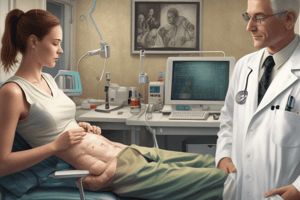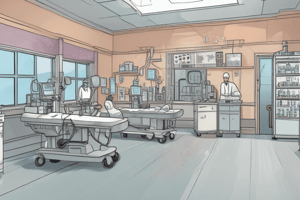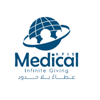Podcast
Questions and Answers
What is the primary ethical responsibility of nurses in promoting patient safety and quality care?
What is the primary ethical responsibility of nurses in promoting patient safety and quality care?
- Implementing cost-cutting measures to improve efficiency.
- Advocating for safe practices and high-quality care. (correct)
- Prioritizing physician orders over patient preferences.
- Following hospital policies without question.
Which of the following best describes a 'near miss' in the context of medical errors?
Which of the following best describes a 'near miss' in the context of medical errors?
- An error that is caught and corrected before reaching the patient. (correct)
- An expected deviation from standard medical practice that poses no risk.
- An error caused by a memory lapse of the healthcare provider.
- An error that results in minimal harm to the patient.
Which of the following scenarios represents an 'error of omission'?
Which of the following scenarios represents an 'error of omission'?
- Documenting incorrect information in a patient's chart.
- Using a contaminated instrument during a surgical procedure.
- Administering the wrong dose of a medication.
- Failing to turn a patient, leading to a pressure ulcer. (correct)
A 'sentinel event' is characterized by which of the following outcomes?
A 'sentinel event' is characterized by which of the following outcomes?
Which factor is most crucial in fostering a culture of safety within a healthcare organization?
Which factor is most crucial in fostering a culture of safety within a healthcare organization?
What is the significance of the 'CUS' mnemonic in promoting a just culture?
What is the significance of the 'CUS' mnemonic in promoting a just culture?
Which approach is most effective in preventing medical errors related to medication administration?
Which approach is most effective in preventing medical errors related to medication administration?
What is the primary goal of the National Quality Forum (NQF)?
What is the primary goal of the National Quality Forum (NQF)?
What is the focus of the Agency for Healthcare Research and Quality (AHRQ) in relation to patient safety?
What is the focus of the Agency for Healthcare Research and Quality (AHRQ) in relation to patient safety?
Which of the following data display tools is most appropriate in health care for illustrating the frequency and distribution of length of stay for surgical patients?
Which of the following data display tools is most appropriate in health care for illustrating the frequency and distribution of length of stay for surgical patients?
What does the Institute for Healthcare Improvement (IHI) primarily aim to achieve through its various campaigns?
What does the Institute for Healthcare Improvement (IHI) primarily aim to achieve through its various campaigns?
Which approach is the most effective way to analyze medical errors and prevent future occurrences?
Which approach is the most effective way to analyze medical errors and prevent future occurrences?
A nurse consistently forgets to document the administration of medications. Which type of error is this considered?
A nurse consistently forgets to document the administration of medications. Which type of error is this considered?
Which of the following actions would be MOST effective to improve patient safety regarding medication errors at the point of care?
Which of the following actions would be MOST effective to improve patient safety regarding medication errors at the point of care?
Which of the following is the first step in the Quality Improvement (QI) process?
Which of the following is the first step in the Quality Improvement (QI) process?
Which of the following is the most accurate definition of a 'violation' in the context of patient safety?
Which of the following is the most accurate definition of a 'violation' in the context of patient safety?
How does the Donabedian Model contribute to quality improvement in healthcare?
How does the Donabedian Model contribute to quality improvement in healthcare?
What is the primary aim of a Root Cause Analysis (RCA) following a patient safety event?
What is the primary aim of a Root Cause Analysis (RCA) following a patient safety event?
You're investigating an increase in patient falls during a specific period. Which data display tool would best assist in identifying potential causes?
You're investigating an increase in patient falls during a specific period. Which data display tool would best assist in identifying potential causes?
Which of the following is the most accurate definition of a 'slip'?
Which of the following is the most accurate definition of a 'slip'?
Flashcards
What is a medical error?
What is a medical error?
Failure of a planned action to be completed as intended or the use of a wrong plan to achieve an aim.
What is an error of omission?
What is an error of omission?
An error where an action is not taken.
What is an error of commission?
What is an error of commission?
An error where the wrong action is taken.
What are unsafe acts?
What are unsafe acts?
Signup and view all the flashcards
What is a 'slip' in medical errors?
What is a 'slip' in medical errors?
Signup and view all the flashcards
What is 'lapse' in medical errors?
What is 'lapse' in medical errors?
Signup and view all the flashcards
What is a mistake?
What is a mistake?
Signup and view all the flashcards
What is a near miss?
What is a near miss?
Signup and view all the flashcards
What is an adverse event?
What is an adverse event?
Signup and view all the flashcards
What is a sentinel event?
What is a sentinel event?
Signup and view all the flashcards
What is a systems approach to avoid errors?
What is a systems approach to avoid errors?
Signup and view all the flashcards
What is incident reporting?
What is incident reporting?
Signup and view all the flashcards
What is a 'just culture'?
What is a 'just culture'?
Signup and view all the flashcards
What is CUS?
What is CUS?
Signup and view all the flashcards
Agency for Healthcare Research and Quality (AHRQ)
Agency for Healthcare Research and Quality (AHRQ)
Signup and view all the flashcards
What does The Joint Commission do?
What does The Joint Commission do?
Signup and view all the flashcards
Principles of Quality Improvement
Principles of Quality Improvement
Signup and view all the flashcards
The four key principles of QI
The four key principles of QI
Signup and view all the flashcards
What is Donabedian Model?
What is Donabedian Model?
Signup and view all the flashcards
Institute Healthcare Improvement Model
Institute Healthcare Improvement Model
Signup and view all the flashcards
Study Notes
Improving Safety and Quality Care
- High-quality nursing leads to better patient outcomes.
- Patient safety is a global and national concern.
- 44% of harmful events are preventable.
Role of the Nurse
- Positively impacts both patient safety and quality of care.
- Nurses are ethically obligated to promote safety and quality.
- Integral to ensuring patient safety in all care aspects.
- The ANA Code of Ethics has an imperative statement about safety.
- Key position to impact patient safety and quality care, with a moral obligation to promote them.
Medical Errors Defined
- Failure to complete a planned action as intended, or using the wrong plan to achieve an aim.
- Adverse events are patient safety incidents caused by medical management.
- Errors of omission mean action is not taken.
- Errors of commission mean wrong action is taken.
Unsafe Acts
- Error occurs where a potential hazard exists.
- Some errors result from violations, which are deliberate deviations from safe practice.
Types of Medical Errors
- Slips are execution errors that don't result in the intended outcome and are observed by others.
- Lapses are execution errors with memory failure, observable only to the nurse.
- Mistakes involve wrong decisions or actions due to incorrect knowledge or judgment.
- Near misses are potential errors discovered before they are carried out.
- Adverse events/patient safety events happen when a patient is injured by medical management.
- Sentinel events, such as death or permanent harm, require intervention to sustain life and must be reported.
Causes of Medical Errors, Approaches
- Can be attributed to human factors or system errors, unintentional
Human Factors Contributing to Medical Errors
- Includes staffing levels and shortages.
- Includes staff education and competencies.
Communication Factors
- Includes patient and family communication.
- Includes intraprofessional & interprofessional communication.
Leadership Factors
- Includes organizational structure.
- Includes policies and procedures.
- Includes practice guidelines.
How to Avoid Medical Errors
- Establish a culture of safety.
- Standardize processes via a systems approach.
- Initiate initiatives to improve safety.
- Use appropriate data analysis tools.
- Collect data on errors and incidents to identify improvement opportunities and track progress.
Incident Reporting
- Needed for incidents, events, or unusual occurrences.
- It's often self-reported and required by regulatory bodies.
- This includes patient falls, employee injuries, visitor injuries, and medical errors.
- Reporting is done by the person who observed the incident or first arrived on the scene.
- The priority is to ensure the patient is safe.
- Only facts should be documented.
- Do not include that an incident report was completed in the patient's medical chart. These reports are often completed on a computer system and should help maintain a culture of safety.
Examples of Errors
- A nurse misinterprets a patient’s symptoms and administers the wrong medication because they believed the patient was experiencing anxiety, but it was a cardiac issue.
- A nurse prepares to administer the wrong medication but realizes the error after double-checking the patient’s medication and MAR and does not give the medication.
- A nurse forgets to document a medication administration or fails to give a scheduled dose of medication.
- A nurse intends to give a patient an oral medication but accidentally administers it via IV because they reached for the wrong syringe and another nurse witnesses the error.
Classifying Errors
- Examples include mistakes, near misses, lapses and slips.
Culture of Safety Details
- Provides a blame-free environment and supports nurses.
- Encompasses 3 stages: safety management is based on rules and regulations, safety is an organizational goal, and safety performance is dynamic and continuously improving.
- Focus on regulatory bodies and compliance.
- Safety should be addressed as organizational goals
- Safety is everyone's responsibility, emphasizing communication, training, and management analysis, focusing on what/how, not who.
Just Culture
- Is fair to those who make an error.
- Encourages nurses to learn from one another.
- Nurses should report all errors without fear.
- Focuses on responsibility with constructive feedback.
- Is a part of a safety culture
- Staff members can voice concerns when there is a safety risk through CUS which includes; being concerned, being uncomfortable and determining if it is a safety issue.
Standardization
- Important for identifying potential ways something can be used and reasons for its use.
Patient Safety Initiatives
- Agencies: AHRQ, ANA, NQF.
AHRQ
- Agency for Healthcare Research and Quality is a foundation for understanding patient safety using a systems approach.
- The Patient Safety Network (PSNet) website is a resource for safety information.
- Provides leaders with tips to prevent medical errors and measure healthcare quality.
ANA
- American Nurses Association handles patient safety and quality initiatives.
- The National Database of Nursing Quality Indicators (NDNQI) reflects elements of patient care affected by nursing quality and quantity.
- Includes structure indicators (staffing), process indicators (hand hygiene), and outcome indicators (pressure ulcer rates).
National Quality Forum (NQF)
- Responds to the Advisory Commission, Consumer Protection, and Quality in the Health Care Industry Act.
- Intends to help Americans have more affordable healthcare and improve their health.
- Focuses on reducing hospital admissions, healthcare-associated conditions, and harm from inappropriate care.
IHI (Institute for Healthcare Improvement)
- Founded in the late 1980s improve healthcare by removing roadblocks and introducing innovations.
- Has initiatives like the 100,000 Lives Campaign which reduces morbidity and mortality in the U.S. health-care system
- The 5 Million Lives Campaign reduces illness or medical harm.
IHI Initiatives
- Rapid Response Teams, MI Protocols, medication reconciliation, central line bundles (CLABSI), surgical site infection prevention, and acquired pneumonia prevention.
- Focus on preventing catheter-associated UTIs (CAUTI), sepsis, ulcers, MRSA, surgical site infections, and CHF.
- Utilizes assistance from board members to assist in care improvements.
The Joint Commission
- Accredits and certifies health-care organizations and reviews agency activities related to sentinel events.
- Supports informed patients through the Speak Up programs
- Has national patient safety goals developed in 2002
WHO (World Health Organization)
- Committed to patient safety since 2002, addresses it as a global health issue
- Through the Patient Safety Program & High 5’s Project, aimed to reduce 5 safety concerns in 5 countries with medication accuracy at transition of care.
- Also focuses on correct procedures, medications, communication, and infection control.
Principles of Quality Improvement
- Stem from total quality management originating in other industries, used in healthcare for measurable improvements.
Key Principles of QI
- QI works as systems and processes.
- Focuses on patients, team, and data.
QI Process
- Setting, measuring, evaluating, and improving care standards involves evaluation improvements.
- Nurse leaders and managers are critical, able to improve patient care by applying QI principles using a patient-centered approach.
- Encompasses structure, process and outcome.
QI Steps
- Step one involves what to monitor where government agencies govern standards, how care is provided and paid, and monitoring activities that fall below expected performance.
- Step two involves prioritizing monitoring of activities jeopardizing patient safety. Occurrences that have serious health consequences.
- Step three involves selecting approaches for assessment depending on the type of information needed, and avoids focusing solely on outcome measurements.
- Step four involves weaknesses in structures and processes that lead to failures.
- Step five necessitates the use of medical records, surveys, financial records, statistical reports, databases and direct observation.
- Step six includes monitoring that can be anticipatory, concurrent, or retrospective (most frequent)
- In step seven there should be activities for improving monitoring coordinated by the department or unit
- Step eight involves a behavior change with the goal of changing the structure and processes.
Models of Quality Improvement
- Donabedian, Lean, Six Sigma, IHI, FMEA, and Root Cause Analysis.
Donabedian Model
- Provides a framework to draw inferences about the quality of healthcare.
- Is a starting point for any QI activity by looking at three categories of information.
Lean Model
- Focuses on doing more with less by reducing waste
- Includes frontline nurses in QI process.
- Focuses on nonvalue-added activities, workarounds, issues, and staff empowerment.
Six Sigma
- Rigourously defines, measures, analyzes, improves, and controls to define the number of acceptable errors produced by a process.
- Improve, design, and monitor processes to minimize or reduce waste.
IHI Model of Improvement
- Asks what are we trying to accomplish, how we will know the change is improvement, and what changes will result in improvement.
- Involves plan-do-study-act cycles and small changes
Failure Modes and Effects Analysis (FMEA)
- Determines which aspect of the process needs to change and establish an action plan to prevent future failures.
- Should look at the process and make predictions about what could go wrong.
Root Cause Analysis (RCA)
- Focuses on identifying and understanding the causes of an event.
- Completed after patient safety events.
- Looks at the sequence of events, causal factors, the root cause, and an action plan.
Quality Improvement Tools
- Communicate information and determine problems
- Help with data collection, trend identification, and problem display.
- Chosen depending on the QI project.
Run Chart
- Communicates data and trends over time.
- Includes vertical and horizontal axes.
- Helps nurse managers investigate possible causes.
Bar Chart
- Common for displaying categorical data.
- Horizontal axes contain categories and frequencies, percentages are on the vertical axis.
- Managers can use to illustrate categorical data.
Histogram
- Type of bar chart to display frequency distribution
- Useful for unavailable time sequences in order to assist the team.
- Recognizing numerical chart data, finding the mean and median and illustrating length of surgical stays.
Fishbone Diagram
- Also known as an Ishikawa or cause-and-effect diagram.
- Can determine root causes and identify relationships and retrospective reviews related to outcomes.
- Can be used to investigate a medication error or event.
Pareto Chart
- Resembles a bar chart which helps determine how to work on a problem based on the 80/20 principle.
Flow Chart
- Clarifies processes, helps develop new processes, and aids in understanding.
- Shows steps, identifies complexity and non-value steps.
- Can help managers identify issues in the admission process.
Important Topics
- Culture of safety, QI principles, steps of QI process, QI models, error identification and JCO patient safety initiatives.
Studying That Suits You
Use AI to generate personalized quizzes and flashcards to suit your learning preferences.





